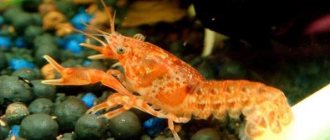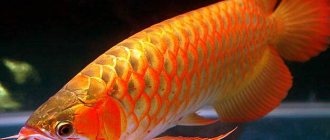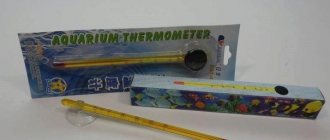Mexican oak is a fast-growing, unpretentious aquarium plant. Mexican Oak (trichocoronis Rivularis) is a fast-growing, unpretentious aquarium plant. This plant can rightfully be called an aquarium starting plant. For this purpose, it is not often used, since there is an opinion that to start a new aquarium it is better to use hornworts of different species or elodea.
Greetings!
I'll tell you a little about the aquarium plant Mexican oak . The homeland of this plant is the southern and central parts of North America - hence one of its names. It grows along the banks of rivers and streams. Hence its other name - Shinnersia Rivularis . Oak grows well both under water and above water, forming dense thickets similar to oak shoots. Shinersia leaves are almost an exact copy of oak leaves.
The plant is very unpretentious. Any lighting is suitable for him. In bright light, Mexican oak will delight you with the beautiful colors of its leaves. The tops of the plant are especially beautifully colored when it reaches the surface of the water or even rises above the surface. The upper rosette of leaves turns brown. This can be seen in the photographs below.
I invite you to my group on VK using the link: “Aquarium plants. Fishes. Saint Petersburg." Feel free to join the ranks. In my spare time from my main job, I work on aquarium plants. This is my hobby. I don't have a store, just a few aquariums with plants. There are also some fish. You can read what kind of fish I have on the page: “Endler’s El Tigre Guppies (Campoma El Tigre)” There are other fish. I can send plants to any region. Thermal packaging.
Mexican oak grows very quickly. If you want to maintain a beautiful bush, then you need to constantly cut off the tops 15 cm long once a week and plant new ones in the ground. The plant is so unpretentious that even very short cuttings take root! Oak can grow both in nutritious soil and without it in a ceramic ring. The main thing is that there is good nutrition in the water. Macro, micro, potassium in abundance. I make my own macrofertilizers. You can read it on the page “Inexpensive fertilizers for aquarium plants in St. Petersburg.” I make both mono-solutions and solutions that contain three components: nitrogen, phosphorus and potassium. If you supply carbon dioxide, the plant will become even more beautiful and grow even faster.
Important! If you simply trim the shinersia Prirucheina bush with scissors, it will produce a lot of side shoots. These shoots will shoot upward, but the leaves on them will be much smaller than on the mother plant. The plant shreds and will be unsightly. After such pruning, some aquarists become disappointed in the plant and throw it away. So, feel free to remove the plant from the soil and replant the tops in the same place, then the leaf will always be juicy, large, and beautiful in color.
Oak cuttings can be tied together into one bush with cotton thread and planted in the ground to a depth of 5-7 cm. A thin cotton thread will quickly rot.
Spreading
From the name of the plant it is clear that its natural habitat is located in Mexico. Small streams and rocky rivers are a natural home for trichocoronis.
However, the species Shinnersia rivularis was bred artificially in the European nursery Dennerle, and the material for selection was taken from the Rio Alamos River, which flows in the northern part of Mexico.
Young leaves have a carved shape similar to oak leaves. The closer to the roots, the less oak-like they are, they have an oblong shape and a faint green color.
Tips for flower growers
These flowers are unique and amazing. Today, more than six hundred and fifty species of these flowers are known. These are varieties of pompom, feathery, bristly, spherical, anemone-shaped, low-growing, semi-double and double oaks. They are annual and perennial. Each of the varieties is interesting in its own way. And caring for such flowers requires knowledge, diligence, desire and great love for flowers.
It happens that the chrysanthemum does not bloom. And the question immediately arises: why? So what should I do? If by autumn your favorite chrysanthemum bush has not bloomed, it means mistakes were made while caring for it. Typical mistakes include:
- lighting. Perhaps the sun's rays illuminated the plant for less than seven hours a day. And this light was too little for the flower. Or perhaps there was too much lighting. When the plant was exposed to light for more than ten hours. The plant is tired of this.
- Pinching done at the wrong time can also be one of the reasons why chrysanthemums do not bloom.
- Lack of fertilizers. It is necessary to feed the plant with phosphorus or potassium. The plant can be saved from the invasion of leaf rollers, slugs, and caterpillars with ash, mustard, herbal infusion, and chemicals.
- These same drugs can get rid of powdery mildew, leaf spot, rust, and chlorosis.
- A very large amount of moisture leads to fungal diseases in plants.
- Viral plant diseases lead to the fact that chrysanthemums suddenly begin to fade. In this case, it is necessary to immediately dig up the diseased bush and burn it.
- If chrysanthemums were grown in a greenhouse, then they simply need to be dug up for the winter.
- For the winter, you don’t have to hide chrysanthemums indoors, which are adapted to the winter cold.
Interestingly, chrysanthemums, speaking in the language of flowers, are considered a reflection of longevity. And if you were given these amazing flowers, then know that they wished you long life from the bottom of their hearts. And this is worth a lot.
Growing and care
Mexican oak grows quickly and requires regular pruning of its leaves.
As soon as it reaches the top of the aquarium and leaves the water column, flowering begins. The color of the oak tree is shaped like yellow hemispheres and resembles the ground dandelion. If the oak tree decides to escape from the aquarium, the upper part of the shoot can be pinched off and immediately planted in the ground.
Water parameters for ideal maintenance
The internal climate of the aquarium should resemble the tropics: water hardness should not exceed 20 units, acidity should not exceed 8, and the uppermost temperature limit should not exceed 32°C.
It is possible to maintain such conditions by regularly replacing ¼ of the water with settled liquid approximately once every 10 days.
Lighting requirements
Shinnersia prefers rich light and develops comfortably at parameters of 0.4 – 1.0 W/l. Weaker lighting causes an increase in the distance between leaves and a loss of color brightness.
Excessive light causes the leaves to change color from light green to brownish brown.
Requirements for soil, nutrient substrate
The root system is fibrous, unpretentious and well developed. The plant also does not have any special requirements for soil quality. All you need is 3 cm or more of sand.
Shinnersia can grow not only in the ground, but also simply lying on the surface of the water. This makes the Mexican oak tree suitable for cultivation in a paludarium, herbal garden, as well as easy to care for and easy to grow in a classic aquarium.
Requirement for fertilizers
Mexican oak is unpretentious and grows very quickly, which means it does not require additional personal fertilizers. It takes essential microelements from water and soil.
If the plant does not look healthy and receives enough light, it is necessary to use tests to determine water quality (for example, VladOx or UHE). When it is clear what exactly the plants lack, you can start choosing fertilizers.
Reproduction, breeding of kadango
This process is not complicated and is identical to the reproduction of most cichlids. Stimulation for spawning is increasing the temperature of the aquarium water and abundant feeding of live food.
Spawning can successfully take place both in a general aquarium and in a separate tank with a volume of 100 liters or more. During this period, producers are aggressive.
An amazing feature of Kadango is their love for black matte surfaces. They love to spawn on filter plastic and even sponges. Therefore, for their convenience, it is advisable to place a black flat stone in the aquarium.
Kadango male and female photo
Spawning itself occurs “in nooks and crannies,” which is not typical of their everyday behavior and is a signal for the aquarist. Like other Malawian females, the female Kadango incubates her eggs in her mouth. The most interesting thing is that she releases the young as “adults”; the young can reach a centimeter in size.
The young Kadangos themselves look like anyone, just not their parents, it’s hard to even imagine that these are future Kadangos!!! The first day the juveniles do not eat anything and stay in a flock. On the second day, the young animals should be fed with live dust or ground dry food as standard.
Over time, the flock of young cadangos disintegrates. Some begin to noticeably increase in size - these are males, while others, on the contrary, lag behind in growth - these are females.
Lifehacks by content
If you accidentally break a Mexican oak while cleaning your aquarium, do not throw away the broken branch, but plant it in the ground to get a new plant.
Many aquarists specially shorten trichocoronis about once every month and a half in order to plant new plants and get young shoots from old ones.
You can tell that the best conditions have been created for Mexican oak by looking at the shape of the leaves. The more comfortable the plant is, the more carved the leaf plates become. They reach out to the surface of the aquarium, become more powerful and acquire a rich color.
Faded and weak leaves of Shinnersia in sufficient light may indicate iron deficiency.
Plant propagation methods
Propagating oak trees is not particularly difficult, so even novice gardeners can cope with this work. Plants can be propagated in the following ways:
- Dividing bushes.
- By cuttings.
- Seed propagation.
You can divide the bushes throughout the growing season. You just need to dig up part of the old rhizome, carefully separate the shoots with roots and transplant them to a new place. Such divisions must be planted at a distance of 30 centimeters from each other.
Oak shoots quickly form roots, which makes it easy to propagate such plants, obtaining the required number of layerings. Cuttings are best done in late summer and early fall. At home, the cuttings are planted in fertile soil, within a few months the shoots develop roots and in the spring you can easily transplant them to their permanent place of residence.
Seed propagation is possible only when using purchased seeds, since if you produce them yourself, the germination rates will be minimal, and the grown flowers may not retain their grade. The easiest way is to plant seeds at home, providing the seedlings with greenhouse conditions. Subsequently, the seedlings are picked and transplanted into separate containers, and as soon as the height of the seedlings reaches 20 centimeters, they can be transplanted into open ground in May. Flowering after transplantation begins at 4-5 months.
Appearance
The aquarium Mexican dragon lives in the wild at an altitude of more than 2000 m above sea level. Outwardly, it resembles a large salamander with a length of 9 to 35 cm from the muzzle to the tip of the tail. Males have a longer tail than females. The head is large and wide, slightly out of proportion with the body, the eyes are small and the mouth is wide. Like all aquatic larvae, they are predators.
Ambystoma exist in two forms - neotenic with external gills and terrestrial developed with smaller gills. She has three processes on the sides of her head - these are gills. The mouth has small teeth that serve to hold food.
Body color can be either white or black, with gray-brown and brown. Light-colored axolotls are more vulnerable in the wild and are therefore rarely found there. They are bred in an aquarium.
How many years do they live? According to research, the life expectancy of such pets is about 20 years, and in captivity, where proper care is given, it is 10 years.
Is it possible to keep at home?
How long will a water dragon live if kept at home? The aquarium lifestyle can be harmful to such an animal if it is not properly cared for. You need to feed him properly; he also needs low temperatures and more than 40 liters of water in the aquarium. If you take into account all the wishes of the Mexican dragon when keeping it in captivity, it will live a long and happy life.
Axolotls can live in an aquarium with a volume of 50-100 liters (from 50 liters per individual). Equip the aquarium with driftwood, large pebbles, pots or coconuts. The skin of the Mexican salamander is very delicate, so as not to damage it, pointy objects should be removed.
The first and important point is temperature. How many degrees is optimal for water? Elevated temperature is their worst enemy, as for any amphibian. In the wild, they live at altitude, so the usual water temperature is below 21 o C. Temperatures above 24 o can lead to illness and death of the pet. Relatively warm water contains little oxygen; the aquarium should be allowed to aerate. The limit temperature is 23 o C. If you are not sure that you can maintain cold water in the aquarium, then it is better to leave the idea of purchasing an axolotl for later.
These creatures can be kept in very clean water, free of chlorine, with a neutral pH level and medium hardness. The water should flow slowly; an internal filter of the aquarium is required - a powerful one, preferably with a washcloth. The water should be changed every week.
Without aquarium soil, he will be uncomfortable - as there will be nothing to cling to, which will lead to ulcers on the tips of his paws. Axolotls swallow gravel, which can cause them to die. The ideal option is aquarium sand.
Compatibility with other aquarium inhabitants
Experienced experts advise keeping them separately from other animals, and there are a number of reasons for this:
- The external gills of the Mexican dragon can be subject to predatory attacks by fish, resulting in severe damage.
- Axolotls are active at night, so they can attack and feed on sleeping fish.
- It's hard to find a creature that would be suitable as a companion (some are too big, others are too small).
- Axolotls should be kept separately from each other or of equal size: adults or larger individuals may eat small ones.
Watch how the little dragon dances to classical music.
The only exception is goldfish. If you feed them well, the axolotl will not be bothered; moreover, they can live in low water temperatures.
Before choosing food for your axolotl, you need to familiarize yourself with the feeding habits. It is forbidden to feed them by-products from the meat of warm-blooded animals and fish food. It is better to feed with raw frozen sea cocktails, earthworms, cherry shrimp, raw sea fish - hake or cod, mussels or small live fish (guppies, zebrafish, neons). Do not overfeed or leave leftover food at the bottom of the aquarium.
An important point is that axolotls do not have bones, but instead have cartilage tissue. You should not touch them unnecessarily; it is better to do this if absolutely necessary with the obligatory use of a net made of soft fabric.
Breeding
Breeding Mexican salamanders is easy. It is easy to distinguish a male from a female by the cloaca: in the male it is convex, but in the female it is almost invisible. The main mechanism is a change in water temperature; animals sense it very well, so reproduction can occur naturally. You can independently stimulate “courtship” by slightly increasing the water temperature and reducing the length of daylight hours. Then increase the day again and lower the temperature. During reproduction, the male releases spermatophores, which the female collects with the cloaca. She lays fertilized eggs on aquatic plants. After which the parents can be transferred to a separate aquarium.
After 2-3 weeks, larvae will appear, similar to fish fry. Their first food is daphnia, microworms, and Artemia naupilia. Later they can be switched to food for adults.
Now you know how to care for an axolotl. These are cute animals that create an incredible impression with their appearance and lifestyle. Rare in nature, they can settle in your home, bringing with them an exotic tale of the underwater world.
Appearance of Mexican oak
Aquarium forms of Trichocoronis variable are the result of selection. When growing in an aquarium, the height of adult plants can reach up to 20 cm. The stem of Trichocoronis is straight, oval leaves without petioles with a sinuous edge, arranged in pairs opposite each other.
The size of the leaf plate is determined by its location on the stem: the closer to the surface of the water, the larger the leaves.
The lower leaves, located at the very root, measuring 10 by 15 mm, are several times smaller compared to the leaves of the apical part of the plant, reaching a length of 5 cm and 3.5 cm in width.
Mexican oak in an aquarium environment.
The shade of trichocoronis leaves can change along with the brightness level of the light:
- when normal they have a bright light green color;
- when strong, they acquire a reddish tint.
Light veins stand out against the background of the main color. Comfortable living conditions have a beneficial effect on the growth rate of the Mexican oak, allowing it to bring its top closer to the surface of the water and bloom.
It releases a flower arrow above the surface of the water - a shoot on which an inflorescence is formed. Trichocoronis buds, white in color and shaped like an aster or dandelion, are located above the water.
Mexican Oak (Shinnersia rivularis)
Mexican Oak (Shinnersia rivularis)
Post by Roman » Jan 10, 2012, 01:50
General information about Shinnersia rivularis (Mexican oak):
Synonyms: TRICHOCORNIS, SHINNERSIA RIVULARIS Family: Compositae (Asteraceae) Origin: North America Difficulty: Simple Conditions: Moderate to very strong lighting. Water temperature 18-30°C. KH 2-12°. pH 5.5-9. Dimensions: Height 50+ cm. Width 10-15 cm. Growth rate: Very fast
Additional information on Shinnersia rivularis (Mexican oak):
Mexican oak is a very unpretentious plant. The leaves are green, carved, and have a characteristic leaf shape similar to an oak leaf, which is how the plant got its name. Trichocornis can be rooted or left floating. When grown floating, the leaves become noticeably smaller. When it reaches the surface, the Mexican oak emerges from the water and blooms. Easily propagated by lateral shoots or cuttings.
How to care for an axolotl - water dragon
The Axolotl, or Mexican water dragon, is an amphibian of the Ambystoma family of the caudate order, and is a neotenic Ambystoma larva of certain species. This creature is surprising in that it reproduces before reaching sexual maturity.
Being a larva that has not undergone major metamorphosis, the axolotl has a developed thyroid gland that is not capable of producing sufficient amounts of growth hormone. However, by moving the Mexican dragon to a dry and cool place with a low water level under domestic conditions, it turns into an adult (ambystoma).
Metamorphosis can occur after a few weeks, accompanied by the gradual disappearance of external gills, changes in color and body shape. The axolotl, whose maintenance and care in an aquarium requires a special approach, is very vulnerable as it grows. The fact is that without the consultation and support of a herpetologist, the creature may die during the ripening period.
Axolotl is translated from the Aztec language as “water monster” or “water dog”. Outwardly, it resembles a big-headed newt with three pairs of external gills sticking out to the sides. The fantastic animal lives in the waters of lakes Xochimilco and Chalco (Mexico) in the Chinampas areas, but due to rapid urbanization its range is shrinking. It is listed in the Red Book as an amphibian under threat of destruction.
Before the Spanish invasion of America, the Aztecs ate axolotl meat, considering it medicinal. It can be easily propagated at home and therefore has scientific value. An interesting fact is that axolotls can regenerate gills, tail and limbs. In captivity, they bred as many colors of the Mexican animal as a lover of aquarium inhabitants would want to see.
Watch the life of axolotls in an aquarium.
Quickly navigate to the article
What to feed daphnia when breeding at home?
I feed my daphnia yeast. They write that you need frozen baker's yeast. It's not obligatory. You can buy regular dry yeast in bags. If your dough rises from them, then there is yeast there. Dissolve a small amount of dry yeast in a small container, such as a regular mug or glass. Stir them and let them stand for 5-15 minutes. Then mix and pour into a jar with daphnia crustaceans. The water should become slightly cloudy. It is better to pour too little than too much, as the water may spoil and the daphnia will die. So don't take risks the first time. Fire up a few jars. Since you will have few crustaceans at first, they will need little food. When Daphnia noticeably multiplies, then it will be possible to add more diluted yeast. Daphnia should clear the water within a few days. After the water has become clear, add more food.
At the request of visitors, I am publishing a video from the BudniAkvariumista channel. The video clearly shows how to feed the moin crustacean.
It is recommended to feed daphnia in the morning so that during daylight hours it eats most of the food. When breeding Daphnia at home, you can also feed it with algae. If you place containers with crustaceans on the windowsill, then after a while the water in them will turn green, as they say, “bloom.” These are unicellular algae. Daphnia feeds on them and it is believed that such crustaceans are very beneficial for fish. Don't overheat the jars! Don't forget to add some yeast. Daphnia needs nutrients. Not all of these substances are found in unicellular algae.
Feeding the kadango
Despite their rugged appearance, kadangos are not predators as such. Their diet in nature consists of insects and small crustaceans. Their jaws are not designed for killing and aggression. By the way, this is why all skirmishes involving Kadango cost “little blood.”
Such gastronomic preferences make these fish easy to feed. In captivity, kadangos eat whatever is offered to them: dry, frozen food, live food, homemade mixes.
Feeding any aquarium fish should be correct: balanced, varied. This fundamental rule is the key to the successful keeping of any fish, be it guppies or astronotuses. The article “How and how much to feed aquarium fish” talks about this in detail; it outlines the basic principles of the diet and feeding regime of the fish.
In this article, we note the most important thing - feeding fish should not be monotonous; the diet should include both dry food and live food. In addition, you need to take into account the gastronomic preferences of a particular fish and, depending on this, include in its diet food either with the highest protein content or, conversely, with plant ingredients.
It should be noted that when purchasing any dry food, you should pay attention to the date of its manufacture and shelf life, try not to buy food in bulk, and also store food in a closed state - this will help avoid the development of pathogenic flora in it
Description of the species
Korean chrysanthemums are perennial flowering plants that can reach a height of 120 centimeters, depending on their variety. The stems of oak trees are erect, thin, and pubescent on top. In appearance, the leaves on the stems resemble oak leaves, hence the name of these flowers. Flower buds are reed-shaped and tubular, located in inflorescence baskets. During the flowering period, up to 400 inflorescences can simultaneously open on one full-size bush.
These are unpretentious flowers that easily take root in any type of soil, and they grow especially well and are decorative in loose, well-drained soil.
Chrysanthemums are light-loving plants, therefore, when choosing a site for a flower garden, you should remember that in the sun the oak trees will be distinguished by their maximum decorativeness. At the same time, every gardener and novice summer resident will be able to care for oak trees.
Gardeners today know several hundred varieties of chrysanthemums, which are perfectly zoned for the Russian climate, are unpretentious in care and are distinguished by their excellent decorative properties. Oak flowers, the care and propagation of which are not difficult, make it easy to create a full-fledged flower bed on your garden plot.
Common varieties include:
- Margarita is distinguished by snow-white flowers, and the height of the bush can reach 70 centimeters. Flowering of this variety begins at the end of August and lasts until the cold weather.
- Valentina Tereshkova. An easy-to-care variety of oak trees, which is distinguished by its crimson inflorescences and compact shrub size. Flowering begins in September and lasts 2-3 months.
- Spring Sunset is a dwarf variety whose shrub height usually does not exceed 50 centimeters. The peculiarity of this variety is the characteristic crimson red color of the inflorescences and the flowering duration, which is 3-4 months. Low-growing spherical oak flowers of this variety will perfectly decorate a personal plot.
- Modesty. A powerful shrub can reach a size of a meter in width and a height of 150 centimeters. The flowers are a delicate pink shade and are 6 centimeters in diameter. Flowering begins at the end of August and continues until the cold weather.
- Viva botany. The chrysanthemum of this variety blooms for 65 days. Oak flowers are semi-double, pronounced yellow in color. The height of this variety of shrubs does not exceed 55 centimeters, which allows this variety to be used to create original small flower beds.
By purchasing high-quality planting material in specialized stores, you can be completely confident in the quality of the flowers planted in the flowerbed.
The gardener needs to remember that most varieties of oak trees are hybrids, so it will be impossible to obtain seeds from them on your own. When choosing one variety or another, it is necessary to take into account its size, flowering period, as well as agricultural cultivation techniques.











